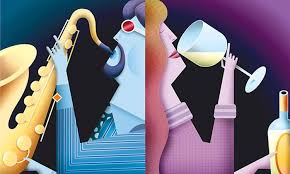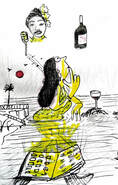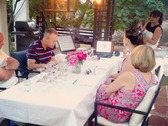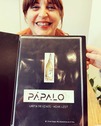 My Encounters with Wine, moves to the cafeteria car of the train. It is an idea that haunted my head for a while and at the suggestion of a great friend, so this time and taking advantage of a tedious and endless train ride for family visit, I got to it...After riding five cars from my seat, I arrived at the cafeteria car-bar. I asked about the availability of wines, my surprise was that they only had red, in Benjamin format bottle, which is equivalent 1/4 to standard bottle. I could not choose, was Beronia crianza 2016, with D. O. Rioja. I asked for white wine and they were out of stock. Its price, 3.60 euros.  It seems that Renfe, at least on long-distance trains like this Talgo, does not bet, not cares for the subject of catering service, nor many others... I proceed to the opening of a screw-cap and serve it in a plastic glass. Its colour surprises me, because its garnet-clean with a fairly high robe was not within my expectations. I accompanied it with a triple sandwich, half vegetable and half mixed, which I appreciated, because the temperature of the wine along with the plastic, caused a twinge in my stomach. With aromas, I managed to get nothing but the aging of the wine, sorry, and on the palate, structured and (background)high-roast) In this case, the meaning and origin of the word CATA (tasting), which comes from Latin captare, which means to,” to grab”, just set me up! Since the rattle of the train, it forces you to do it... hahaha This has been my humble and optimistic version of events. I encourage you to taste our excellent broths in different means of transport, perhaps, a demand for it, would give us more alternatives! CURIOSITIES: I'll talk a little about the aroma of coffee or roasted in wine : The legend of the origin of coffee is curiously reminiscent of that of wine, Some Yemeni monks would have verified an unusual excitement among their goats and they would have noticed that they ate the fruits of an unknown shrub, so the monks tasted these fruits... The Jewish legends say that Noah would have discovered the wine in the same way and its effects, observing the strange behavior of a goat intoxicated by fermented grapes. Coffee is probably native to Ethiopia but its cultivation spread throughout numerous tropical and equatorial countries, especially Central and South America. The aroma of coffee comprises more than 850 components, among which furfurfurilmercaptan (Furan-2-ilmetanotiol is an organic compound containing a furan substituted with a sulfanymethyl group. It is a clear, colourless liquid when pure, but turns yellow when standing for a long time. It has a strong smell of roasted coffee and a bitter taste) has an important role. This scent of wine resembles, like cocoa, all the nuances called roasting and its presence seems similarly linked to the aging in new barrels and the warming that they undergo during the willow ... OBSERVATIONS: It is not the same to drink a glass wine in a high-end glass than to make it in a plastic glass ... To realize it is not necessary to be understood or stretched ... simply do a simple test, pouring the liquid in two different cup formats, you'll see that even the water knows otherwise. With wine, a liquid element full of aromas and flavours that you want to enjoy, it happens the same, so the glass takes on special importance if what you like is not just drinking the wine, but enjoying it. These should be the correct characteristics of a good glass: Transparency. The glass has to be neutral, not distort colours that we may want to appreciate, especially if we drink rosés or wines with years of aging in the bottle. The shape is the most important after the material, which preferably has to be glass, since according to the silhouette of the glass, aromas can be concentrated better than others. For example, narrow glasses, usually, are not good for poking your nose and start perceiving fruit or spices. Depending on the shape of the cup and especially its upper part, its opening, it will "throw" the wine to one part or another of the mouth, and depending on that "geographical" area, you will be able to perceive the sweet, the bitter, the saline ... A narrower cup, for example, throws the wine to the tip of the tongue, stimulating the sweet perception. If it is wider, the liquid goes further back and excites other areas and different taste buds.
0 Comentarios
Deja una respuesta. |
irene sayasEntusiasta y conocedora de la magia del vino. El vino evoca, convoca y provoca... *Archivos:
|
Cómo contactarnos / How to contact usTeléfono 690 073 871 |
Suscribirse / SubscribeÚnete a nuestra lista de correo hoy!
Sign up to our mailing list now! |












